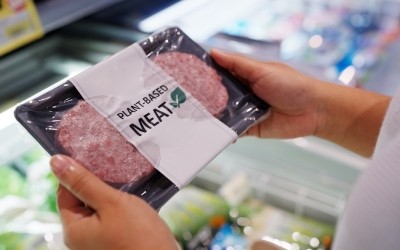Can plant-based seafood gain mainstream acceptance through familiar flavors, strategic placement in the frozen food section?

As reported in FoodNavigator-USA in April, the plant-based seafood market is still in its nascent stages with more room for innovation on flavors, textures and applications. While consumers may find plant-based seafood as mix-ins for other meals, appealing to the frozen category could offer more visibility for consumers and innovation for brands.
“I see a lot of opportunity to have things in the frozen aisle, where consumers can just reheat and eat,” explained Gretchen Moon, VP commercial operations, Planteneers to FoodNavigator-USA.
In 2020, as consumers stocked up on shelf-stable foods, frozen foods reached $65.1 billion in retail sales, a 21% increase in dollars and 13.3% increase in units over the previous year, according to the American Frozen Institute. Seafood was one of the top frozen food categories seeing 35.3% growth, indicating a “rediscovery of the frozen foods aisle.”
More recently, seafood consumption declined in response to inflation according to FMI – The Food Industry Association; however frozen seafood has been able to maintain more market share compared to fresh seafood, offering an avenue for plant-based seafood to establish presence.
Familiar formats and flavors may push plant-based seafood to the front
Plant-based seafood has the potential to gain traction through familiar flavors such as smoke, lemon, pepper, honey, and barbecue that are already well-known and accepted in mainstream cuisine.
“Once you get people willing and enjoying those mainstream flavors, then you can move up the flavor adoption curve by branching out with something new,” Moon said.
The key is combining ingredients to make the right texture and taste profiles, Moon explained. This includes a combination of different plant-based proteins like pea and fava with hydrocolloids and other materials like starches, fibers and flavors.
“In the case of plant-based seafood products,” Moon explained, “one of the things we have to consider is the blend that we put together which has to be very white in color and as clean and tasty as possible to work well in that.”
Compared to other plant-based alternatives, the taste profile of seafood varietals is nuanced, light and delicate. Customizing different texture systems based on the format of the seafood variety creates a more authentic experience, said Moon.
“The consistency of something like a plant-based salmon filet is going to be incredibly different than that of a piece of sushi or a fish stick. It’s all about combining these types of ingredients in the right way to give the appropriate texture,” Moon added.
Frozen plant-based seafood brands are adopting familiar formats through breaded and seasoned products, while advertising ingredients, nutrition and preparation suggestions for consumers to grab and go.
Good Catch Plant-Based New England Style Crab Cakes touts “real seafood taste, lump crabmeat-style texture and high protein content” on the front of its packaging and a recipe for a vegan cocktail sauce on the back. The cakes are made of a protein blend—pea protein isolate, soy protein concentrate, chickpea flour, faba protein, lentil protein, soy protein isolate and navy bean powder.
Be Leaf’s Vegan Shrimp includes its ingredient list on the front packaging: konjac powder, vegetable gum, vegetable root starch, paprika, brown sugar, sea salt, vegan seasoning; as well as gluten-free, soy-free and low-carb claims. A recipe for sweet and sour vegan shrimp is printed on the back of the package.
Although Vegan Zeastar's Notuna Sashimi is not a frozen product, the brand provides transparency to consumers by clearly listing the primary ingredients and corresponding quantities on the label—water 80%, trehalose 5% and modified tapioca starch 2%.
For plant-based foods, customers want it to mimic as closely to the animal version as possible. This means using the right textures and stabilizers, as well as finding the right taste profile that fits the product, Moon explained.
![[Watch] Cavi-art showcases seaweed-based caviar, shrimp alternatives](/var/wrbm_gb_food_pharma/storage/images/_aliases/wrbm_medium/publications/food-beverage-nutrition/foodnavigator-usa.com/trends/plant-based-alt-proteins-precision-fermentation/watch-cavi-art-showcases-seaweed-based-caviar-shrimp-alternatives/16740539-1-eng-GB/Watch-Cavi-art-showcases-seaweed-based-caviar-shrimp-alternatives.jpg)
















